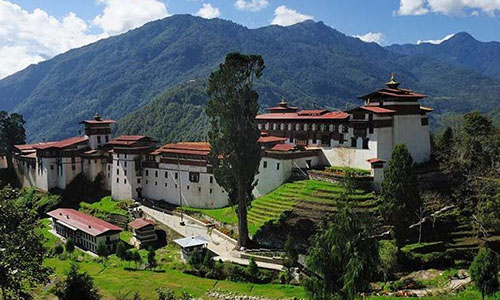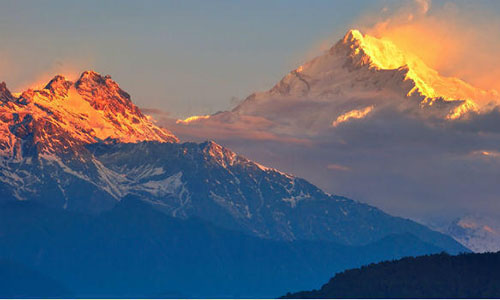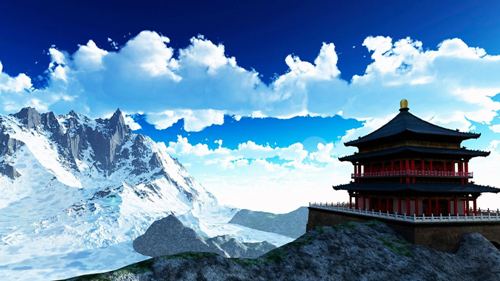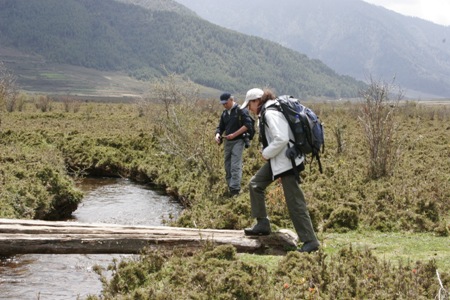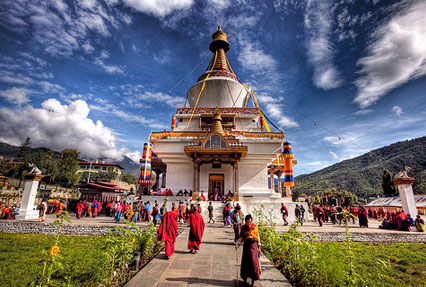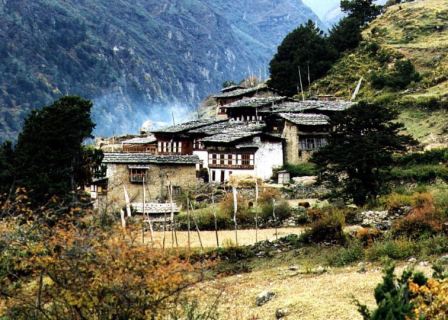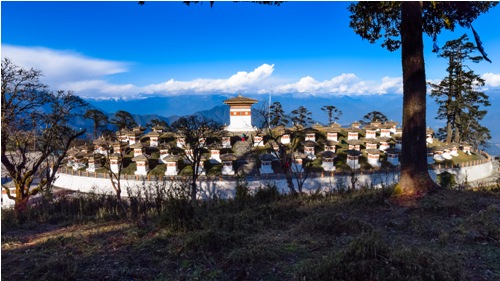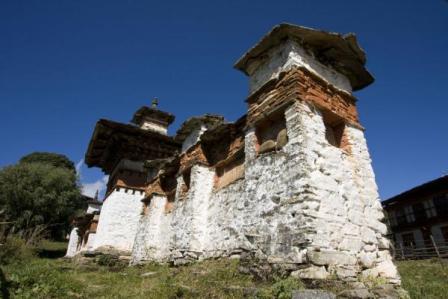Bhutan
“Mountains, Monasteries and Magic”
Bhutan Tourism-A Glimpse
 Bhutan is one of those countries that has maintained its tradition and culture even during the modern times. Travellers can experience not only the taste of Buddhist culture but also stunning natural sceneries. Bhutan is the only remaining Vajrayana Buddhist nation in the world, and the profound teachings of this tradition wield a very strong weight on the everyday lives of the people.
Bhutan is one of those countries that has maintained its tradition and culture even during the modern times. Travellers can experience not only the taste of Buddhist culture but also stunning natural sceneries. Bhutan is the only remaining Vajrayana Buddhist nation in the world, and the profound teachings of this tradition wield a very strong weight on the everyday lives of the people.
What’s Great?
Amazing weather at all times. Picturesque surroundings. Rich cultural history.
What’s not so Great?
Roads can at times be unsafe, especially during rains. A threat of natural hazards like landslides and earthquakes like in any hilly terrain.
For Whom
Nature lovers. Pilgrims. People fascinated by cultural history.
Regions in Bhutan
Bhutan is geographically and culturally divided into three regions: Central, Eastern and Western. These are then divided into 20 different districts for administrative purposes.
Traditional hotels, cottages and guest houses are easily available with all the essential amenities and facilities. There are a few luxury hotels, but these are very expensive. You can also enjoy a stay amidst the calm and serene environment of the Buddhist monasteries. You might not find a lot of smaller hotels listed online.
Culture of Bhutan
The culture in Bhutan is a blend of Buddhism and Bonism traditions. Giant Phalluses can often be seen painted onto walls to keep the evil spirits away and ensure a positive environment. Dzongkha is the official language. Other languages spoken include Sharcop Kha, Nepali and English. Even though English is taught as the primary language in schools, more emphasis is put on learning Dzongkha. A lot of people also understand Hindi. People commonly wear traditional Bhutanese dress. Men wear Gho, a knee-length robe tied at the waist, and women a Kira, an ankle-length wrap-around accompanied by a jacket known as a Tego. They still wear long scarves while visiting Dzongs and other administrative centres. The colour of scarves signifies the status or rank of the wearer.
Food in Bhutan
Meals are mostly vegetarian, but non-vegetarian meals are also available. The most popular dishes are Datshi (Cow’s milk cheese). Be prepared to savour some Ema Dhatsi (chillies and cheese), Kewa Dhatsi (potatoes and cheese) and Shawa Datshi (mushroom and cheese)
Other dishes include Tshoem (a spicy curry made with beef and mushrooms), Eue chum (Bhutanese red rice), Sha Kam (Dried beef), Hoentoe (Buckwheat dumplings), Jasha Maru (Spicy minced chicken), Goep (Tripe), Ara (alcohol made from fermented rice) and Chang (Local beer). Ema (Chillies) is a popular ingredient in the traditional Bhutanese Dishes.
Tips for visiting Bhutan
- Mineral water is widely available
Milk should be boiled before consumption
Powdered or tinned milk is available
Only eat well-cooked meat and fish
Medical facilities are good but not always close at hand
Officials in Bhutan have reported repeated outbreaks of bird flu
Products containing tobacco (cigarettes, chewing tobacco, etc.) are effectively banned throughout Bhutan (which remains the only country in the world to do so), and penalties for possession or use may be severe
Give and take money with both hands
One needs to be dressed up in fully covered clothes (legs and arms should be covered) while visiting monasteries and other attractions
Carry a raincoat and a jacket at all times
Currency of Bhutan
Bhutanese Ngultrum (BTN)
The Ngultrum is primary currency in Bhutan. Ngultrum (Nu) = 100 Chetrum (Ch). Notes are in denominations of Nu 500, 100, 50, 20, 10 and 5. Coins are in denominations of Nu 1, and 50, 25 and 20 Ch.
Apart from the Ngultrum, the Indian Rupee and US Dollar are accepted as legal tender. Indian rupee holds almost equal value as that of Bhutanese Ngultrum. ATMs only accept Bhutanese bank cards apart from the Druk PNB ATMs. Travellers are thus advised to carry traveller’s cheques in US Dollars or Indian Rupees.
Nightlife in Bhutan
Owing to the strong cultural influence that prevails in Bhutan, there is not much of a nightlife here. 8 PM is considered as the end of a typical working day. However, there are a few underground clubs where the party starts after 10 p.m. on Friday and a few other days of the week. There are a lot of Karaoke clubs where you can sing your heart out.
Shopping in Bhutan
Many hotels even have souvenir shops that sell local handicraft items, clothing, fridge magnets, jewellery, and herbs. Tourists very popularly demand Bhutanese stamps. Normally, these markets and bazaars are open from 8 AM to 8 PM. You can buy souvenirs from the base of The Tiger’s Nest Monastery trek at an affordable price. Don’t forget to bargain though!
Festivals of Bhutan
The most widely celebrated festival is Tshechu or the tenth day and is a major tourist attraction. This festival is celebrated on the tenth day of a month of lunar calendar corresponding to the birthday of Buddhist Guru Rinpoche. All visitors must attend a Tshechu fair and witness the mask dances to receive the blessings and wash away the sins. These mask dances are portrayals of historic incidents that took place in Bhutan during Guru Rinpoche’s time. In monasteries, the mask dances are performed by monks, and in remote villages, they are performed jointly by monks and the village locals.
History of Bhutan
The Buddhist history of Bhutan is known with certainty as a written history was maintained after Mahayana Buddhism was introduced into the country in the 7th century by the King Songtsen Gampo. Widespread conversion to Buddhism was witnessed during this period. For the next thousand years, Bhutan existed as a series of rival monarchies in separate mountain valleys, but Buddhism remains, to date, the integrating factor.
Hygiene in Bhutan
As everywhere in the Indian subcontinent, special precautions must be taken by travellers for Diphtheria, Hepatitis A, Malaria, Rabies, Tetanus, and Typhoid. Bird flu has recently become common in Bhutan, and thus we recommend caution and care. Only drink bottled water or boiled water if it is un-bottled and have fruits and vegetable after washing them.
Customs of Bhutan
The customary greeting is joining palms and bowing down. Money is taken and given with both hands. Display of affection between people of different sexes publicly is not well received, so if you are travelling with your partner, it is advised to avoid getting intimate in public. At monasteries or temples, it is customary to make a small donation to the monks as a sign of respect. Do not smoke at monasteries and in public places, since all tobacco items are strictly banned in Bhutan. In temples or religious places, it is recommended to remove shoes and head gear and wear clothing that expresses respect for the sacred nature of the site and the culture of the country.
Other Trips
These are other trips.


